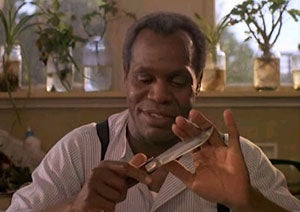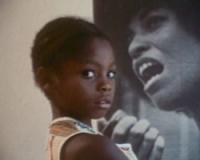A gorgeous new print of Charles Burnett’s To Sleep with Anger (1990) screened at the Billy Wilder Theater on Wednesday night, December 7th. It was a rare treat for many reasons, not least of which being that the film, which won four Independent Spirit Awards, has never been released on DVD. Burnett himself was on hand for the discussion afterward as were a number of members of the production team, including Executive Producer Edward Pressman, producer Caldecot Chub, cinematographer Walt Lloyd, editor Nancy Richardson and actor Sy Richardson.

While the diverse points of view present for the Q&A provided for a wide-ranging discussion, a particularly useful insight arose when Burnett was asked about the idea behind Harry, Danny Glover’s character in the film. Burnett cited a character from African American folklore, the Hairy Man, as the inspiration. The Hairy Man is a shape-shifter who can’t be gotten rid of unless he is outsmarted; traits that are present in Harry, if a less somewhat less fantastical incarnation. Glover’s character is not the only place folklore is visible in To Sleep with Anger. Though folklore is most readily associated with the American South, stories such as “The Hairy Man” were very much a part of life for Burnett growing up in Los Angeles. Burnett wanted to reflect that aspect of his Los Angeles experience in To Sleep with Anger, and did so through Glover’s character as well as other magical realist elements.
While My Brother’s Wedding was Burnett’s last film before To Sleep with Anger (and shot almost seven years prior) there are many similarities between the two films. Even though To Sleep with Anger makesthe larger jump to more conventional filmmaking, including more professional actors, Burnett’s voice is still heard clearly with his attention to local Los Angeles communities and his representation of family traditions during both good and bad times. Going on to direct the crime drama The Glass Shield in 1994 would move Burnett towards more Hollywood-like projects, compared to his more surrealist, folkloric side shown in this film.
What is interesting in considering To Sleep with Anger in the entirety of Burnett’s career is how his use of mythological or surrealist elements work to express real life situations.
What is interesting in considering To Sleep with Anger in the entirety of Burnett’s career is how his use of mythological or surrealist elements work to express real life situations. One of the most iconic images from Killer of Sheep, the shot of Burnett’s niece, Angela (who plays Stan’s daughter in the film) wearing the dog mask provides an appropriate metaphor for larger trends in Burnett’s art. Both bizarre and straightforward simultaneously, the image of the dog mask on the young girl harnesses elements of surprise and strangeness in order to more fully describe reality. Like the Hairy Man in To Sleep with Anger, it is only by going through myth, instead of ignoring or disproving it, that we can better understand the truth. By employing the fantastic, Burnett creates the everyday.
From a more technical standpoint in the Q&A, Walt Lloyd discussed his role as cinematographer. He chose to use AGFA film for no other reason than the fact that he got a great deal on it. He also mentioned his use of tobacco filters, which are used to give film a very warm image and to also complement the skin tone of the actors. The consideration of film stock and lens filters is very important when shooting a cast of African American people. Color film was largely developed by white scientists who were filming white (Caucasian) subjects; when Black people began making films using Black subjects, finding a film stock that was not “prejudiced” became one more hurdle to get through. Once again the use of filters and other lighting techniques is fundamental if one has less control over the film stock chosen. Walt Lloyd also mentioned the other challenges of shooting in a house instead of a set. The kitchen especially was very small and when there were scenes with many actors they could barely fit, let alone the camera and DP. Lloyd once again made choices to make sure everything was filmed in a positive manner. The cinematography was beautiful (as emphasized from the new print straight from the original negative) and learning about the little challenges makes the film itself even more sincere.
—Laura Paul






 Mobile Navigation
Mobile Navigation

